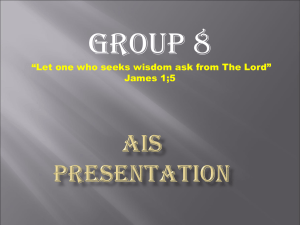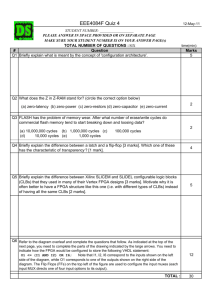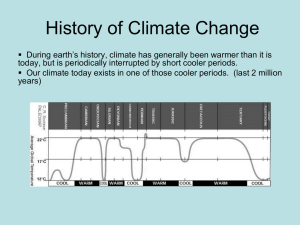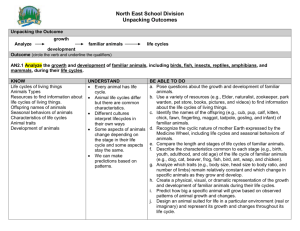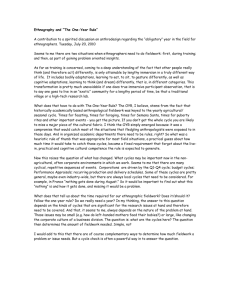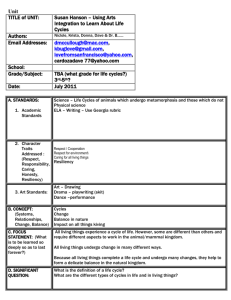Accounting 3603 - KFUPM Open Courseware
advertisement
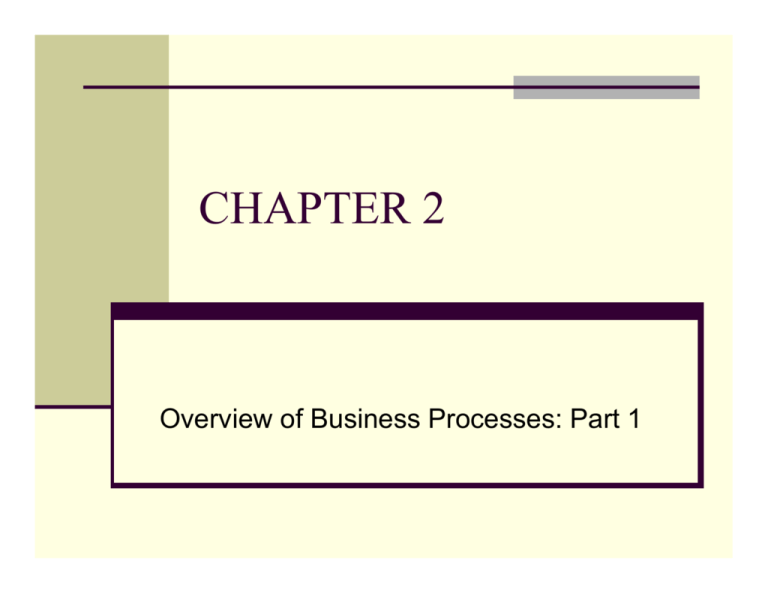
CHAPTER 2 Overview of Business Processes: Part 1 INTRODUCTION Questions to be addressed in this chapter include: What are the basic business activities in which an organization engages? What decisions must be made to undertake these activities? What information is required to make those decisions? What role does the data processing cycle play in organizing business activities and providing information to users? What is the role of the information system and enterprise resource planning in modern organizations? INFORMATION NEEDS AND BUSINESS ACTIVITIES Businesses engage in a variety of activities, including: Acquiring capital Buying buildings and equipment Hiring and training employees Each activity Purchasing inventory requires Doing advertising and marketing different types of decisions! Selling goods or services Collecting payment from customers Paying employees Paying taxes Paying vendors INFORMATION NEEDS AND BUSINESS ACTIVITIES Businesses engage in a variety of activities, including: Acquiring capital Buying buildings and equipment Hiring and training employees Each decision Purchasing inventory requires Doing advertising and marketing different types of information. Selling goods or services Collecting payment from customers Paying employees Paying taxes Paying vendors INFORMATION NEEDS AND BUSINESS ACTIVITIES Types of information needed for decisions: Some is financial Some is nonfinancial Some comes from internal sources Some comes from external sources An effective AIS needs to be able to integrate information of different types and from different sources. INTERACTION WITH EXTERNAL AND INTERNAL PARTIES AIS External Parties The AIS interacts with external parties, such as customers, vendors, creditors, and governmental agencies. INTERACTION WITH EXTERNAL AND INTERNAL PARTIES Internal Parties AIS External Parties The AIS also interacts with internal parties such as employees and management. INTERACTION WITH EXTERNAL AND INTERNAL PARTIES Internal Parties AIS External Parties The interaction is typically two-way, in that the AIS sends information to and receives information from these parties. BUSINESS CYCLES A transaction is: An agreement between two entities to exchange goods or services; OR Any other event that can be measured in economic terms by an organization. EXAMPLES: Sell goods to customers Depreciate equipment BUSINESS CYCLES The transaction cycle is a process: Begins with capturing data about a transaction Ends with an information output, such as financial statements BUSINESS CYCLES Many business activities are paired in give- get exchanges The basic exchanges can be grouped into five major transaction cycles. Revenue cycle Expenditure cycle Production cycle Human resources/payroll cycle Financing cycle BUSINESS CYCLES Many business activities are paired in give- get exchanges The basic exchanges can be grouped into five major transaction cycles. Revenue cycle Expenditure cycle Production cycle Human resources/payroll cycle Financing cycle REVENUE CYCLE The revenue cycle involves interactions with your customers. You sell goods or services and get cash. Give Goods Get Cash BUSINESS CYCLES Many business activities are paired in give- get exchanges The basic exchanges can be grouped into five major transaction cycles. Revenue cycle Expenditure cycle Production cycle Human resources/payroll cycle Financing cycle EXPENDITURE CYCLE The expenditure cycle involves interactions with your suppliers. You buy goods or services and pay cash. Give Cash Get Goods BUSINESS CYCLES Many business activities are paired in give- get exchanges The basic exchanges can be grouped into five major transaction cycles. Revenue cycle Expenditure cycle Production cycle Human resources/payroll cycle Financing cycle PRODUCTION CYCLE In the production cycle, raw materials and labor are transformed into finished goods. Give Raw Materials & Labor Get Finished Goods BUSINESS CYCLES Many business activities are paired in give- get exchanges The basic exchanges can be grouped into five major transaction cycles. Revenue cycle Expenditure cycle Production cycle Human resources/payroll cycle Financing cycle HUMAN RESOURCES/ PAYROLL CYCLE The human resources cycle involves interactions with your employees. Employees are hired, trained, paid, evaluated, promoted, and terminated. Give Cash Get Labor BUSINESS CYCLES Many business activities are paired in give- get exchanges The basic exchanges can be grouped into five major transaction cycles. Revenue cycle Expenditure cycle Production cycle Human resources/payroll cycle Financing cycle FINANCING CYCLE The financing cycle involves interactions with investors and creditors. You raise capital (through stock or debt), repay the capital, and pay a return on it (interest or dividends). Give Cash Get cash BUSINESS CYCLES Thousands of transactions can occur within any of these cycles. But there are relatively few types of transactions in a cycle. BUSINESS CYCLES EXAMPLE: In the revenue cycle, the basic give-get transaction is: Give goods Get cash BUSINESS CYCLES Other transactions in the revenue cycle include: Handle customer inquiries Update sales and Accts Rec. for Take customer orders Approve credit sales Check inventory availability Initiate back orders Pick and pack orders Ship goods Bill customers Note that the last activity in any cycle is to send information to other cycles. sales Receive customer payments Update Accts Rec. for collections Handle sales returns, discounts, & bad debts Prepare management reports Send info to other cycles BUSINESS CYCLES Click on the buttons below if you wish to see the transactions that occur in the other cycles: Expenditure Expenditure Cycle Cycle Production Production Cycle Cycle HumanRes./ Res./ Human PayrollCycle Cycle Payroll Financing Financing Cycle Cycle BUSINESS CYCLES Every transaction cycle: Relates to other cycles Interfaces with the general ledger and reporting system, which generates information for management and external parties. Finished Goods Expenditure Cycle Revenue Cycle Production Cycle ta Da s nd Fu General Ledger and Reporting System The revenue cycle Human Res./ Payroll Cycle Financing Cycle Gets finished goods from the production cycle Provides funds to the financing cycle Provides data to the General Ledger and Reporting System ds n Fu Production Cycle Data Expenditure Cycle Revenue Cycle Raw Mats. General Ledger and Reporting System The expenditure cycle Human Res./ Payroll Cycle Financing Cycle Gets funds from the financing cycle Provides raw materials to the production cycle Provides data to the General Ledger and Reporting System Finished Goods Revenue Cycle Expenditure Cycle Raw Mats. Production Cycle La bo r ta a D General Ledger and Reporting System The production cycle: Human Res./ Payroll Cycle Financing Cycle Gets raw materials from the expenditure cycle Gets labor from the HR/payroll cycle Provides finished goods to the revenue cycle Provides data to the General Ledger and Reporting System Expenditure Cycle Revenue Cycle La bo r General Ledger and Reporting System ta a D Human Res./ Payroll Cycle Production Cycle The HR/payroll cycle: Funds Financing Cycle Gets funds from the financing cycle Provides labor to the production cycle Provides data to the General Ledger and Reporting System Expenditure Cycle Revenue Cycle Production Cycle s nd Fu s nd Fu General Ledger and Reporting System Data Human Res./ Payroll Cycle The Financing cycle: Funds Financing Cycle Gets funds from the revenue cycle Provides funds to the expenditure and HR/payroll cycles Provides data to the General Ledger and Reporting System Expenditure Cycle Revenue Cycle Data D a at ta a D Data General Ledger and Reporting System Production Cycle ta Da Information for Internal & External Users The General Ledger and Reporting System: Human Res./ Payroll Cycle Financing Cycle Gets data from all of the cycles Provides information for internal and external users BUSINESS CYCLES Many accounting software packages implement the different transaction cycles as separate modules. Not every module is needed in every organization, e.g., retail companies don’t have a production cycle. Some companies may need extra modules. The implementation of each transaction cycle can differ significantly across companies. BUSINESS CYCLES However the cycles are implemented, it is critical that the AIS be able to: Accommodate the information needs of managers Integrate financial and nonfinancial data. TRANSACTION PROCESSING: THE DATA PROCESSING CYCLE Accountants play an important role in data processing. They answer questions such as: What data should be entered and stored? Who should be able to access the data? How should the data be organized, updated, stored, accessed, and retrieved? How can scheduled and unanticipated information needs be met. To answer these questions, they must understand data processing concepts. TRANSACTION PROCESSING: THE DATA PROCESSING CYCLE An important function of the AIS is to efficiently and effectively process the data about a company’s transactions. In manual systems, data is entered into paper journals and ledgers. In computer-based systems, the series of operations performed on data is referred to as the data processing cycle.


